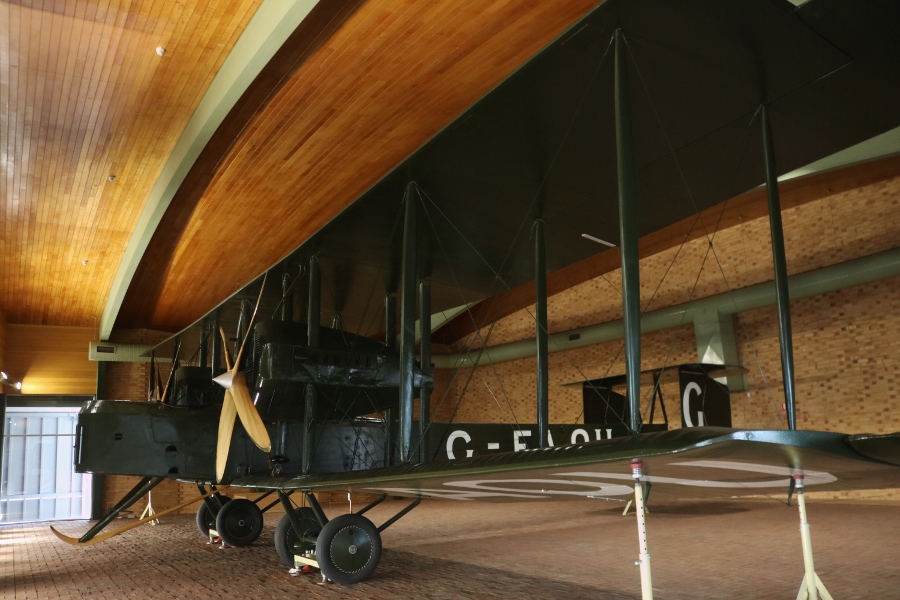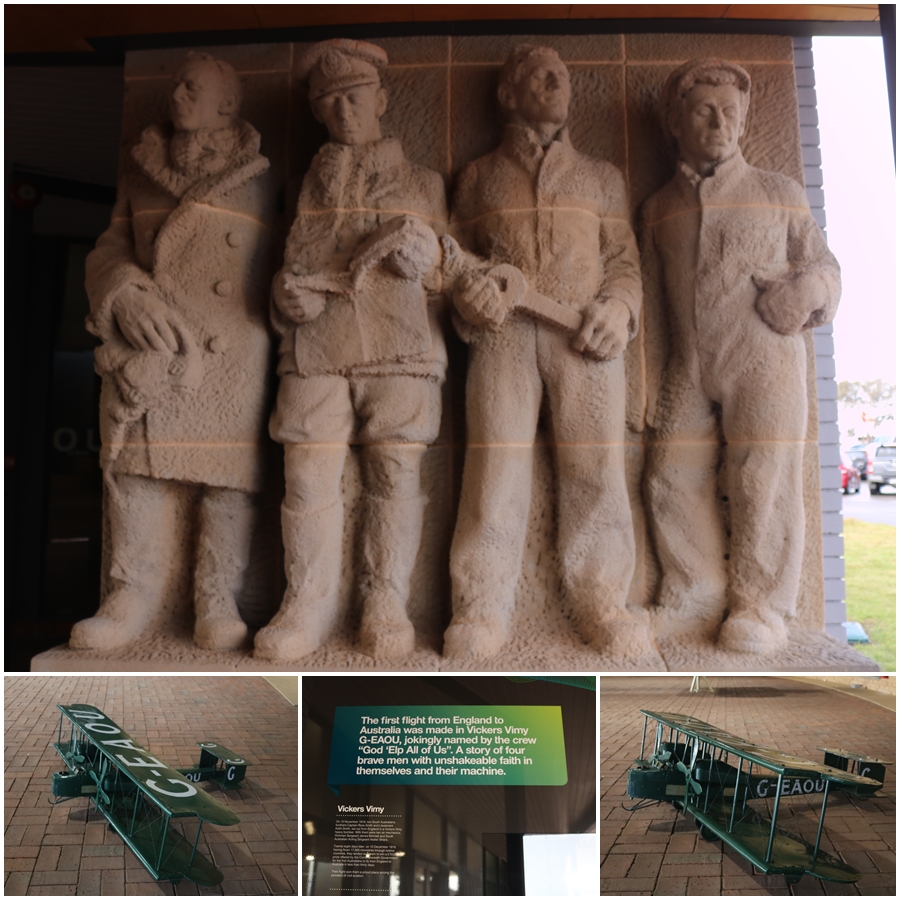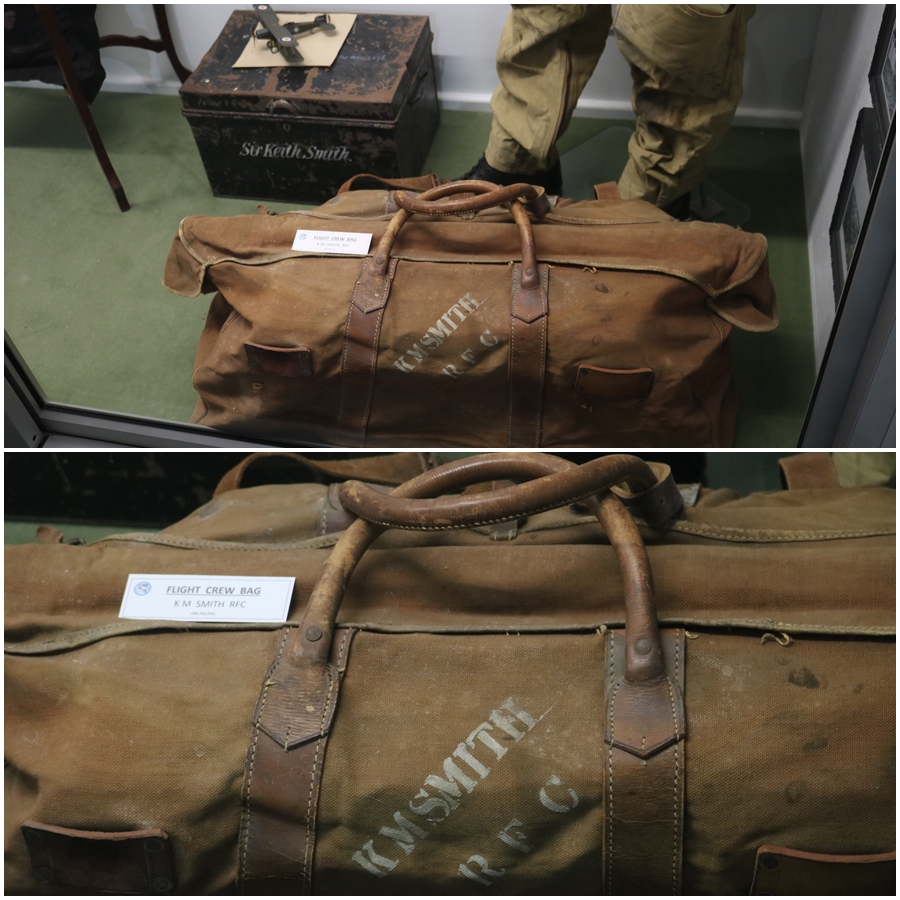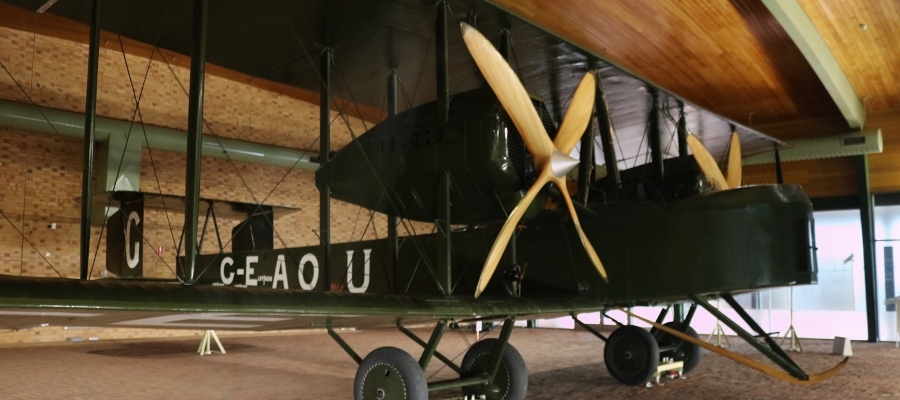At the Adelaide Airport in South Australia is what I still consider to be one of the cities best hidden aviation treasures. The Vickers Vimy and Sir Ross & Sir Keith Smith Memorial building (established 1958) houses the immaculate looking World War One era Vickers Vimy IV G-EAOU (dubbed “God ‘Elp All Of Us“) bomber, that was flown to victory by Australian World War One veteran pilots and brothers, Captain Ross MacPherson Smith (Australian Flying Corps) and Lieutenant Keith MacPherson Smith (Royal Air Force) in the inaugural 1919 England to Australia Air Race.


The Vickers company were persuaded by Ross MacPherson Smith to supply the former Royal Air Force Vickers F.B.27A Vimy IV long-range bomber (s/n F8630) fitted with two 360 HP Rolls Royce Eagle VIII engines for the race. It was delivered too late to see service during World War One but became one of the more significant aircraft in Australian aviation history. The Smith team added extra fuel capacity to extend the big biplanes range, whilst reducing weight by removing the radio and any other unnecessary items and create space, so they could pack the plane with spare parts for the long journey ahead!

The Vickers Vimy was piloted in the race by Ross, with Keith flying as the co-pilot and navigator, along with their Australian military mechanics Sergeants Wally Shiers and Jim Bennett who had served with Ross Smith previously. They set off at 8am in poor weather from Hounslow, England on November 12th, 1919. 27 days & 20 hours later they arrived in Darwin on December 10th after flying the 18,000 km journey at an average of 137 km/h through numerous countries, with many hair-raising experiences along the way!



These men became the first to ever fly an aircraft from England to Australia and became the winner of the first England to Australia Air Race as a result. The crew arrived home as national heroes and apart from an equal share in the £10,000 prize money offered by the Australian Government, the Smith brothers were knighted by King George V (December 22nd, 1919) and the mechanics were commissioned and awarded bars to their Air Force Medals for their daring deed. You can read more about their exploits in my earlier post – Ross & Keith Smith Vickers Vimy & the 1919 England to Australia Air Race.



Following the record-breaking flight the Vickers Vimy was donated by Vickers to the Australian government. In 1921 it became the only Vickers Vimy to enter the RAAF register when it was assigned the serial number A5-1 but it was not put into use and was placed in and out of storage for a number of years before eventually becoming part of the Australian War Memorial collection. By 1958 the aircraft was put on permanent display in Adelaide in the purpose-built building where it remains today (apparently it was partially burnt from an errant cigarette in transit and had to later be repaired!). Adelaide was the birthplace of the Smith brothers. Back in the day, it was front and centre to the old Adelaide Airport terminal building and in the public eye. When the new airport was opened in 2005, the Vickers Vimy remained where it was and now sits in an obscure and almost forgotten location down near the airport staff and passenger long-term parking but most importantly it is at least safe for future generations!

When I first visited the memorial in 2015, there was talk of the Vickers Vimy being relocated to the South Australian Aviation Museum in Port Adelaide or possibly being relocated to a more central location in the new Adelaide Airport Plaza. In September 2018, neither of these options have been put into place due to the fragile nature of the aircraft and also the high cost but it seems the Vimy is going to remain at the airport.
Since my last visit there have been significant changes to the memorial. The air race information has been updated and a multimedia display has been added. I noticed they had also changed the facade of the building by repainting it in a more modern grey look (unfortunately painting over or removing a nice Vickers Vimy mural in the process!), making the external walls extend to the ground and adding a covered walkway to improve weather protection, which is good for the aircraft, car park patrons and also protects the Vimy crew memorial statue too.

The changes to the façade also cuts down the glare a little on the extensive glass of the environmentally controlled display area that encloses the aircraft but it is still a notoriously difficult aircraft to photograph, due to natural light reflection on all that glass! Ideally after 60 years, the viewing area would be enclosed with walls and doors, so it could be darkened to enable better viewing of the Vickers Vimy. To get these most recent photos, I was holding a strategically placed coat to block the light in one hand and the camera in the other – quite the juggling act and not the most stable imagery!

Sadly despite plenty of car park foot traffic, no-one stopped to look at the Vimy whilst I was there (the same thing happened when I was there in 2015). Australian history lives right there people, please take a look!
I note on the Adelaide Airport website they have also gone somewhat politically correct and renamed the building from its original title of Sir Ross & Sir Keith Smith War Memorial, to the new Vickers Vimy and Sir Ross & Sir Keith Smith Memorial. On the building itself, it now simply says Vickers Vimy – First Flight England to Australia 1919.
South Australian Aviation Museum
Although the South Australian Aviation Museum (SAAM) in Port Adelaide does not have the Vickers Vimy, they do have on display a number of personal items that belonged to Sir Ross and Sir Keith Smith, along with models of the aircraft. A nice link to South Australia’s aviation past, which is the primary focus of SAAM.



The Smith Brothers

Sir Ross Macpherson Smith (1892-1922) was born on December 4th, 1892 in Semaphore, Adelaide. He first served with the Australian 3rd Light Horse Regiment in October 1914, then went to Gallipoli in 1915 and the Sinai in 1916 before transferring to the AFC in 1917. He then served with No.1 Squadron AFC (No. 67 Squadron RFC) in the Suez Canal region, first as an observer then as a pilot flying air to air combat, bombing and aerial photography missions against Turkish forces. His exploits during World War One were quite heroic, being awarded the Military Cross (MC) twice, the Distinguished Flying Cross (DFC) three times and also the Air Force Cross (for non-operational flying duties).
His adventurous life was sadly cut short less than three years after his success in the 1919 air race, when Ross died in April 1922 at just 29, in a Vickers Viking amphibious biplane crash in England with mechanic Jim Bennett, whilst preparing for a round the world flight (apparently he had never flown the type before and the crash was put down to pilot error). His brother Keith Smith was unfortunately there to see his brother who he had shared so much adventure in life with, die in that crash. The men were returned to Australia for a state funeral.
Sir Keith Macpherson Smith (1890-1955) was born in Adelaide on December 20th, 1890. He enlisted in the Royal Flying Corps (RFC which later became the RAF) in 1917. Following training he was posted to No. 58 Squadron RFC flying bombers in November 1917. The squadron was deployed to France in January 1918 but saw no combat. The following month he returned to England and flew with No. 75 Squadron RFC for home defence as a gunnery instructor and other training duties. He was discharged from the RAF on November 5th, 1919 and later became the Australian representative for the Vickers company, also serving as director for a number of airlines and companies including Qantas and Tasman Airways until his death in 1955.
During my September 2018 visit, I decided to also pay my respects to these great Australian aviators at their final resting in the family grave plot at North Road Cemetery in Adelaide. I am pleased to report their graves are well maintained and can be located at Plot 6089, Path 23 South.

Rest In Peace gentlemen, your daring deeds have not been forgotten. The Smith brothers legacy may be relegated to the pages of history but I am sure they would gain a great deal of satisfaction in knowing that “God ‘Elp All Of Us“ lives on.
The Survivors
Of the 230+ Vimy aircraft produced by Vickers and licenced manufacturers, the Smith Vimy is one of only two original survivors. The other can be found at the London Science Museum in the UK.
The second survivor, is the Vickers Vimy IV flown by Captain John Alcock (DSC) and Lt. Arthur Whitten-Brown on the first Trans-Atlantic crossing from Newfoundland, Canada to County Galway in Ireland between June 14th to 15th, 1919. They won a £10,000 prize offered by the Daily Mail newspaper in doing so.
Three Vickers Vimy replicas have also been built. Two were built in the UK – the first in the 1950’s for a movie on Alcock and Brown that never eventuated (the fate of the aircraft is apparently unknown) and the other, that was flyable in 1969 (G-AWAU) but following a crash ended up in the RAF Museum Hendon collection. The third, NX71MY was built in the United States by an Australian-American group in 1994 to participate in a number of successful long distance recreation flights (the 1919 Trans-Atlantic flight – recreated in 2005, the 1919 England to Australia Air Race – recreated 1994 and the 1920 England to South Africa flight – recreated 1999) and since 2006 has been on display at the Brooklands Museum in the UK.
References:
RAAF Museum – Westland Wapiti & Vickers Vimy
Please also see my earlier post:
Ross & Keith Smith Vickers Vimy & the 1919 England to Australia Air Race.

These are irreplaceable treasures!!
LikeLiked by 1 person
Very much so
LikeLiked by 1 person
I’d never heard of that particular aircraft. Very interesting and thanks for sharing it with us.
LikeLiked by 2 people
It truly is a hidden secret
LikeLike
You’d think with such an important and iconic aircraft it would be promoted much more and hence visited much more. What a shame it isn’t.
LikeLiked by 1 person
Yes, it’s somewhat of a bugbear of mine
LikeLiked by 1 person
A wonderful memorial to a great flying achievement now a part of aviation history. Determined characters in those days of real flying.
LikeLiked by 1 person
Yes, real determined aviation pioneers!
LikeLike
A fantastic piece of (secret) aviation history! Would that it had greater prominence – over on this side of the ditch we’ve got Jean Batten’s monoplane dangling from the roof of the Auckland international terminal, but the Smith Bros’ achievement, all those years earlier with older technology, seems to me to be the greater.
LikeLiked by 1 person
All great aviators but sometimes history’s pagekind of gets folded over or torn out!
LikeLike
Deano–another of your excellent articles and finding of another gem hidden out in the open. Excellent photos and thanks for your technique tip!
LikeLiked by 1 person
Thanks Joe. I was surprised security didn’t come down to see what the strange guy was doing under the coat!
LikeLike
[…] the memorial building roof and the angled glass, which makes photography much easier than say the Smith Brothers Vickers Vimy Memorial at the Adelaide […]
LikeLike
[…] and his brother Keith Smith would go on to fame flying a converted Vickers Vimy IV G-EAUO bomber to victory in the first England to Australia Air Race in 1919. This was also the first […]
LikeLike
I remember this building in it’s original state very well. It was a must when visiting the new/’then old/.now demolished Adelaide Terminal – very visible and inviting – a modern, airy, bright building in it’s time. Sadly, nobody bothers or even knows what it houses any more. I shall revisit and reacquaint myself with this wonderful piece of Australia’s history.
LikeLiked by 1 person
Well worth a revisit Sue!
LikeLike